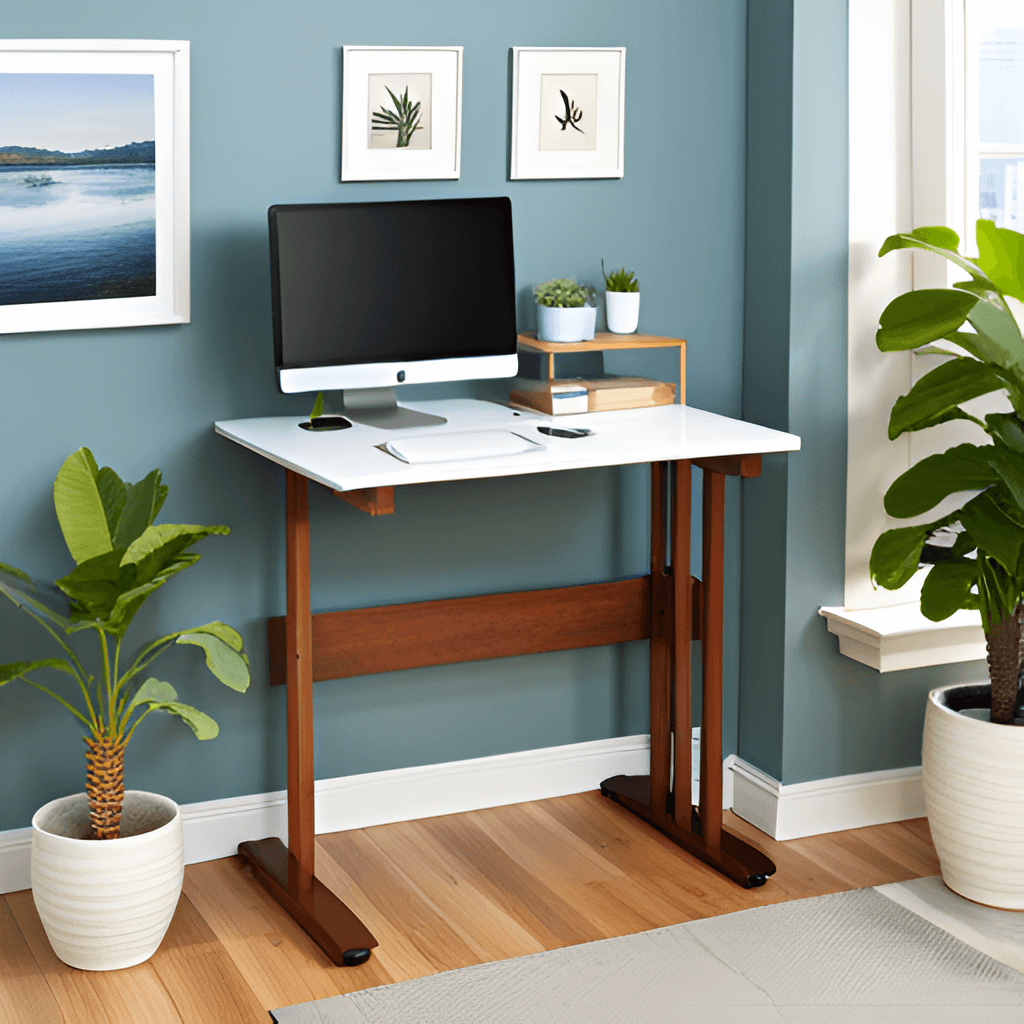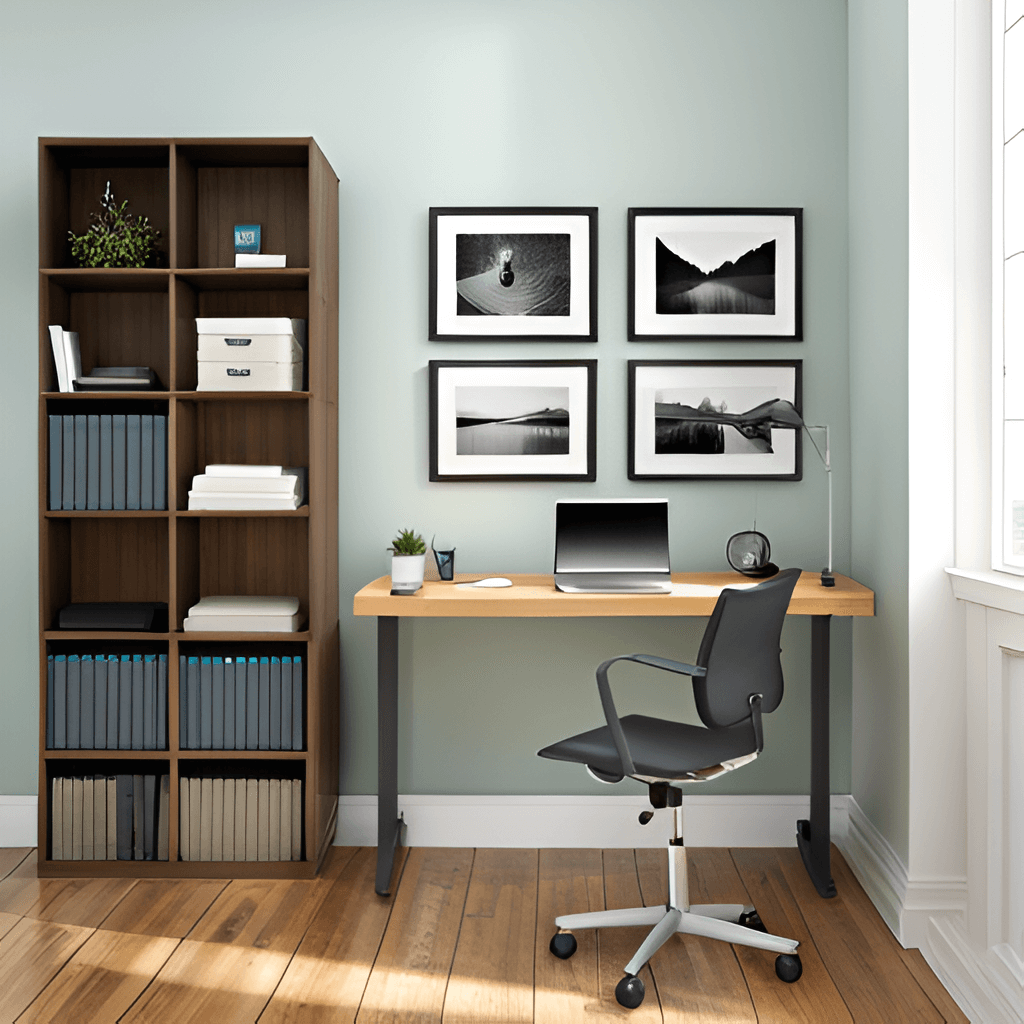
Ergonomic Setup Tips for Your Small Standing Desk
Are you among the growing number of individuals who have embraced the benefits of a standing desk for their home office? If you’re looking to set up a small standing desk, you’ve come to the right place. At Opvital, we understand the importance of ergonomics in your workspace, and we’re here to guide you through the process. This article is tailored to those seeking to optimize their small standing desk setup for comfort, health, and productivity.
For an in-depth guide of small standing desks to choose from, view our small standing desk selection guide!
| Key Takeaways |
|---|
| Ergonomics is crucial for a comfortable and productive small standing desk setup. |
| Choose a small standing desk that suits your space, and consider an adjustable one for versatility. |
| Determine the correct desk height based on your measurements, and ensure it’s suitable for both sitting and standing. |
| Position your monitor at eye level, use a monitor stand or adjustable arm, and maintain a neutral neck posture. |
| Keep your wrists straight and close to your body for an ergonomic keyboard and mouse setup. |
| Use foot support like a footrest and an anti-fatigue mat for added comfort during prolonged standing. |
| Organize cables to reduce clutter and tripping hazards in your workspace. |
| Take regular breaks, be mindful of your posture, and balance sitting and standing for optimal health. |
Section 1: Creating the Perfect Ergonomic Small Standing Desk Setup
When setting up a small standing desk, the first step is selecting the right desk for your space and needs. Here’s what you should consider:
1.1 Measuring Your Workspace
Before making a purchase, measure your office space where you plan to place your small standing desk. Take into account not only the desk’s dimensions but also the space required for you to comfortably move and stand without any obstructions. For a detailed tutorial on how to use a standing desk correctly, check out this article from Ergonofis.
1.2 The Versatility of Adjustable Desks
Opt for an adjustable small standing desk. These desks allow you to switch between sitting and standing positions, offering flexibility and adaptability to your work habits. If you’re weighing the pros and cons between adjustable and traditional desks, our article on Standing Desk Adjustable vs. Traditional Desk can provide valuable insights.
1.3 The Advantages of Small Standing Desks
Compact standing desks are perfect for small home office spaces. They not only save space but also encourage movement, helping you avoid a sedentary lifestyle. Discover more about the advantages of small standing desks on our website.
Section 2: Achieving the Ideal Desk Height
Achieving the correct desk height is crucial for an ergonomic small standing desk setup. A desk that’s too high or too low can lead to discomfort and health issues.

2.1 Determining the Perfect Desk Height
To determine the ideal desk height for your small standing desk, consider your own height. Here’s how to do it:
- Stand up straight with your arms hanging naturally at your sides.
- Bend your elbows at a 90-degree angle.
- Your desk’s height should allow your wrists to rest comfortably on the desk surface while keeping your elbows at this angle.
2.2 Adjusting the Height for Comfort
If you’ve chosen an adjustable desk, customize its height based on your measurements. Most adjustable desks have a control panel or buttons that make this process straightforward.
2.3 Balancing Sitting and Standing
Remember that your small standing desk should also accommodate a sitting position. Follow the same guidelines to determine the ideal sitting desk height, ensuring it’s comfortable for typing and mouse usage when seated.
Section 3: Monitor Placement and Eye Level
Proper monitor placement is essential to prevent neck and eye strain while working at your small standing desk.
3.1 Monitor Placement
Position your monitor directly in front of you, so you don’t have to turn your head to see the screen. This reduces neck strain.
3.2 Eye Level
Adjust the monitor’s height so that the top of the screen is at or just below eye level. This promotes a neutral neck posture and reduces strain on your neck and upper back.
3.3 Monitor Stand or Adjustable Arm
Consider using a monitor stand or an adjustable monitor arm to achieve the correct height and angle for your screen. This allows you to fine-tune the monitor’s position to your exact needs.
Section 4: Keyboard and Mouse Setup
The way you position your keyboard and mouse is crucial for maintaining a comfortable and ergonomic workspace.

4.1 Correct Placement
Position your keyboard and mouse so that your wrists remain straight and your arms are close to your body. This minimizes strain on your wrists and shoulders.
4.2 Ergonomic Input Devices
Consider investing in ergonomic keyboards and mice designed to promote a natural hand and wrist position. These devices can significantly reduce the risk of repetitive strain injuries.
4.3 Keyboard Tray or Stand
To achieve the proper wrist and hand position, use a keyboard tray that can be adjusted to the right height or an adjustable keyboard stand. This ensures that your keyboard is at the correct height, whether you’re sitting or standing.
Section 5: Foot Support and Anti-Fatigue Mat
Don’t forget about your feet and overall comfort while standing at your desk for extended periods.
5.1 Foot Support
Use a footrest or an adjustable footstool to provide support and relieve pressure on your lower back and legs. This helps reduce discomfort during prolonged standing.
5.2 Anti-Fatigue Mat
Consider placing an anti-fatigue mat under your desk. These mats are designed to reduce the strain on your legs and feet by providing a cushioned surface to stand on.
5.3 Comfortable Footwear
Choose comfortable and supportive footwear that complements your standing desk setup. Proper shoes can make a significant difference in your overall comfort.
Section 6: Cable Management
Maintaining a clutter-free workspace not only looks neat but also reduces the risk of accidents and distractions.
6.1 Tidy Cables
Ensure that your cables are organized and secured. Use cable clips, cable sleeves, or cable management trays to keep them out of the way and prevent tripping hazards. Career Karma provides top tips and considerations.
6.2 Safety and Aesthetics
Effective cable management not only enhances safety but also contributes to the aesthetics of your workspace. A clean and organized setup can boost your productivity and focus.
Section 7: Regular Breaks and Posture Awareness
Even with an ergonomic setup, it’s crucial to take breaks and be mindful of your posture.
7.1 Regular Breaks
Take short breaks to stretch and move around. Standing desks are meant to encourage movement, so use this opportunity to maintain your overall health.
7.2 Posture Awareness
Pay attention to your posture while working. Maintain a neutral spine, engage your core, and avoid slouching. Regularly check your body positioning to ensure you’re not straining any muscles.
Additional Insights for an Optimal Setup
7. Monitor Placement for Dual Monitors
If you use dual monitors, ensure both screens are at the same height and directly in front of you. This prevents neck strain caused by constantly turning your head.
8. Wireless Accessories for Convenience
Consider using wireless keyboards and mice. They reduce clutter and allow for more flexibility in positioning your input devices.
9. Ergonomic Accessories for Health
In addition to ergonomic keyboards and mice, explore other ergonomic accessories such as laptop stands and monitor risers. These can further enhance your setup.
10. Plants and Personalization
Personalizing your small standing desk area can do wonders for your mood and productivity. Consider these tips:
- Greenery: Add some indoor plants to your workspace. Plants not only purify the air but also create a refreshing and inviting atmosphere.
- Artwork: Hang artwork or photos that inspire you. Aesthetically pleasing visuals can boost creativity and motivation.
- Decorative Elements: Incorporate decorative elements such as desk organizers, colorful stationery, or unique desk accessories that reflect your personality.
11. Regular Maintenance
Maintaining your small standing desk setup is essential for long-term comfort and functionality. Here’s what you should do:
- Stability Check: Periodically check your desk for stability. Make sure all bolts and screws are tightened, and the desk remains level.
- Cable Management: Revisit cable management to ensure cords are organized and not obstructing your workspace. Replace damaged cables as needed.
- Accessories Update: If your ergonomic accessories show signs of wear or discomfort, consider upgrading to maintain a comfortable workspace.
Regular maintenance ensures your small standing desk setup continues to support your well-being and productivity effectively.
Conclusion
Creating an ergonomic small standing desk setup is a journey toward a healthier and more productive work life. By following the tips outlined in both Part 1 and Part 2 of this guide, you’re well on your way to a workspace that supports your well-being and efficiency.
Remember to listen to your body, take breaks, and maintain good posture. Stay tuned to Opvital for more insightful articles on work-life balance, productivity, and optimizing your home office. Your success and well-being are our top priorities.
Thank you for choosing Opvital as your trusted source for work-life and productivity advice.
Stay productive, stay healthy, and keep striving for excellence!
FAQs
Small standing desks are ideal for compact spaces, but they may not be suitable for everyone. It’s essential to consider your comfort and work habits. If you’re unsure, try a sit-stand desk converter to test the concept before investing in a full desk.
To prevent fatigue, ensure you have proper footwear, use an anti-fatigue mat, take regular sitting breaks, and pay attention to your posture. These steps will help reduce discomfort during extended standing periods.
Yes, there are several exercises you can do. Try calf raises, ankle circles, and gentle stretches to keep your muscles engaged and relieve tension. Incorporate these into your regular breaks.
Small standing desks can be used with laptops, but it’s essential to have an external keyboard and mouse to maintain proper ergonomics. This setup ensures your screen is at eye level, and your hands and wrists are comfortable during use.
When selecting ergonomic accessories, consider your specific needs. Look for products like ergonomic keyboards, mice, monitor stands, and footrests that match your workspace’s size and your own comfort requirements.
Read More
- Digital Marketing Tools: The Importance of Marketing Tools
 The Importance of Marketing Tools In today’s digital landscape, businesses …
The Importance of Marketing Tools In today’s digital landscape, businesses …Digital Marketing Tools: The Importance of Marketing Tools Read More »
- A Guide to Fundamental Marketing Tools for Businesses
 What are marketing tools? At Opvital, we’re dedicated to shedding …
What are marketing tools? At Opvital, we’re dedicated to shedding …A Guide to Fundamental Marketing Tools for Businesses Read More »
- The Significance of Marketing Tools
 Key Takeaways for Marketing Tools Marketing Tools Overview – Diverse …
Key Takeaways for Marketing Tools Marketing Tools Overview – Diverse … - A Comprehensive NeuronWriter Review: Unveiling Its SEO Powers
 Welcome to Opvital’s in depth NeuronWriter Review. NeuronWriter is more …
Welcome to Opvital’s in depth NeuronWriter Review. NeuronWriter is more …A Comprehensive NeuronWriter Review: Unveiling Its SEO Powers Read More »
